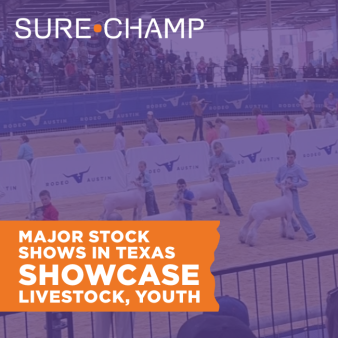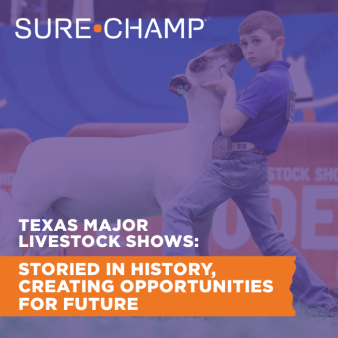
Summer is winding down, and school is kicking off, so here’s a pop quiz to get you to get back into classroom mode. What event lasts nearly 30 days every year and ends on July 4? Which county fair drew more than 1.5 million visitors this summer, making it the largest county fair in the country? What fair is located on 300-acre fairgrounds just a mile from the beach? If you answered the San Diego County Fair at Del Mar, Calif., you just aced this quiz.
Unlike many of the weeklong county fairs that people in the Midwest or other parts of the country are accustomed to, many California county fairs run for multiple weeks hosting numerous competitions, educational and entertainment opportunities. Jacky Eshelby, Exhibits Director at the San Diego County Fair, is no stranger to fairs. She grew up exhibiting livestock across California fairs, and raised her children, Nolan, Kayla and Lilly Hildebrand, to discover the passion only found in the barn. Eshelby has worked in the fair industry for 27 years. She explains what makes California county fairs, and especially the San Diego County Fair unique.
For starters, the fair starts in late May or early June each year and ends on July 4. This year it lasted 27 days. However, the fair is closed on Mondays and Tuesdays, giving both staff and fair partners (concessions, entertainers, mid-way partners) a much-needed time to regroup. The San Diego County Fair is situated on 300 acres and houses a huge variety of educational exhibits and competitive displays ranging from the typical livestock to floral design and a one-of-a-kind wood working competition known as Design in Wood. As the Exhibits Director, Eshelby oversees anything competitive, educational and all fair décor.
“Our fair is unique because we rebrand with a unique theme and rebuild around the theme, so the fairgoers have a different experience each year. In 2019 our theme was ‘OZ Some’ and celebrated the Wonderful Wizard of Oz. We took an entire building and devoted it to Frank L. Baum’s famous story that was later the inspiration for the 1939 MGM movie. From educational displays to endless photo opportunities, there were unlimited possibilities to find memories skipping down the yellow brick road,” Eshelby said.
A few of the other agricultural attractions at the San Diego County Fair include The Farm, World of Horses, and the California Grown Building, an educational exhibit that features all the products grown within the state. The fair also hosts numerous livestock shows and concludes with a junior livestock show the final week.
Perhaps one of the most distinct features of the San Diego County Fair is the way it was structured in the 1930s. According to Eshelby, who also taught a Fair Management course at Cal Poly San Luis Obispo for 14 years, California fairs are unique because in 1933 when the pari-mutuel act to legalize horse betting was passed, California allocated the money from horse racing to create District Agricultural Associations and fair network.
“There were originally 54 District Fairs in California when horse racing was legalized, and 52 are still active today as state-owned entities, out of 78 fairs including the state fair. We are unique because the San Diego County Fair is actually the 22nd District Agricultural Association, formed in 1936,” she said.
And though it is a state-owned facility, the management and the upkeep is the responsibility of the fair. The facilities are available for rent a majority of the year. One renter, the Del Mar Thoroughbred Club, hosts the Del Mar horse races twice a year, the summer meet (mid July – Labor Day) and the fall meet (November). Due to its sheer size, and with an attendance of more than 1.5 million people, it is the fifth largest fair in the country, just coming in behind Houston, San Antonio, State Fair of Texas and the Minnesota State Fair.
Lessons from the Sale Ring
With a fair that size in a fairly urban area, they host a large 4-H and FFA livestock show. She said nearly 600 market goats, lambs, hogs and steers were exhibited this summer, and since youth can only sell one animal, about 400 animals were sold during the livestock auction. One of Eshelby’s tasks since coming to this fair has been establishing the Junior Livestock Fund to help build support for the youth in the sale, while also educating the community about what the young livestock exhibitors are learning from their projects.
“The Junior Livestock Fund has really changed the way we tell the story to the area supporters. Not everyone has a freezer, or they don’t have room for a half a beef. However, they do understand that these kids are entrepreneurs. They are learning lifelong skills, such as responsibility, animal husbandry, bookkeeping, record keeping, marketing skills and how food goes into supply chain,” she said.
And although buyers and buyer groups can still support the sale and get their fresh meat processed for their freezer, they do have the option to come and support the kids without actually taking home the animal.
Educating the Attendees
Eshelby has taken time in her role to sit among and observe the “ultra-urban fairgoer” to gain more understanding of how the fair can educate the public about agriculture and the efforts young exhibitors put toward their livestock projects.
“During the FFA market hog show, a mom and her kids were sitting there, and the kid asked the mom if they were at the pig races, and the mom said ‘yes, we are.’ This made me realize, we have a different story to tell than what is commonly told ringside. We need to do a better job of talking in the show ring – explaining what is going on, and make it more like a talk show than a livestock show because there are so many misperceptions of the ultra-urban consumer of what their perception of a ring full of hogs represents. What is normal to us in the world of livestock, makes no sense to someone born and raised in a cement jungle,” Eshelby said.
Showmanship Matters
Have you ever noticed how many young livestock exhibitors from California and other Western states have a standardized dress code that typically includes wearing white pants? While the San Diego County Fair is moving away from the white trousers, Eshelby said the long-standing California 4-H dress code includes white shirt and trousers, 4-H scarf or tie and the 4-H hat on the person, which means if not on the head, could be tucked over the belt. The FFA dress code has included white shirt and trousers, FFA scarf or tie and the blue jacket.
Showmanship is a very important competition in California, and she said the exhibitors spend countless hours practicing for the contest, with many setting goals to win or at least improve from the year previous. She said because it is so prestigious, exhibitors still wear the traditional dress code to make a good impression or in case someone from a more traditional background is judging.
Celebrating the Wins
“The difference between fairs and festivals is fairs celebrate the success of ordinary citizens. When you award a blue ribbon to recognize someone, especially a child, you are creating that memory and they are part of that event and that attraction and that is something to smile about,” Eshelby shared about her favorite part of being involved in the fair.
She said the community also comes out to celebrate the youth who are successful with their livestock projects. The grand champion market animals are selected on a Thursday evening, and even though that might only include 16 exhibitors, the grandstands are full of family and community members who come out to watch and support the young people.
California fairs offer different perspectives, and the San Diego County Fair definitely wins the purple ribbon for size. However, you can all learn the same lessons and experience the same opportunities if your fair is 2 days or 27 days. County fairs teach lessons about winning, losing, educating the consumer and making new friends. And those are lessons you can use Every. Day.

